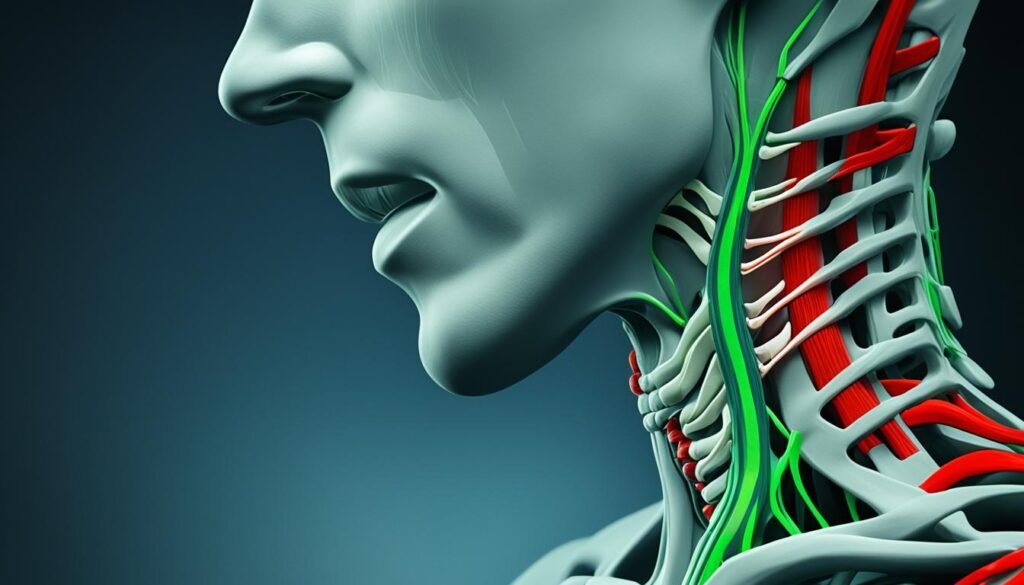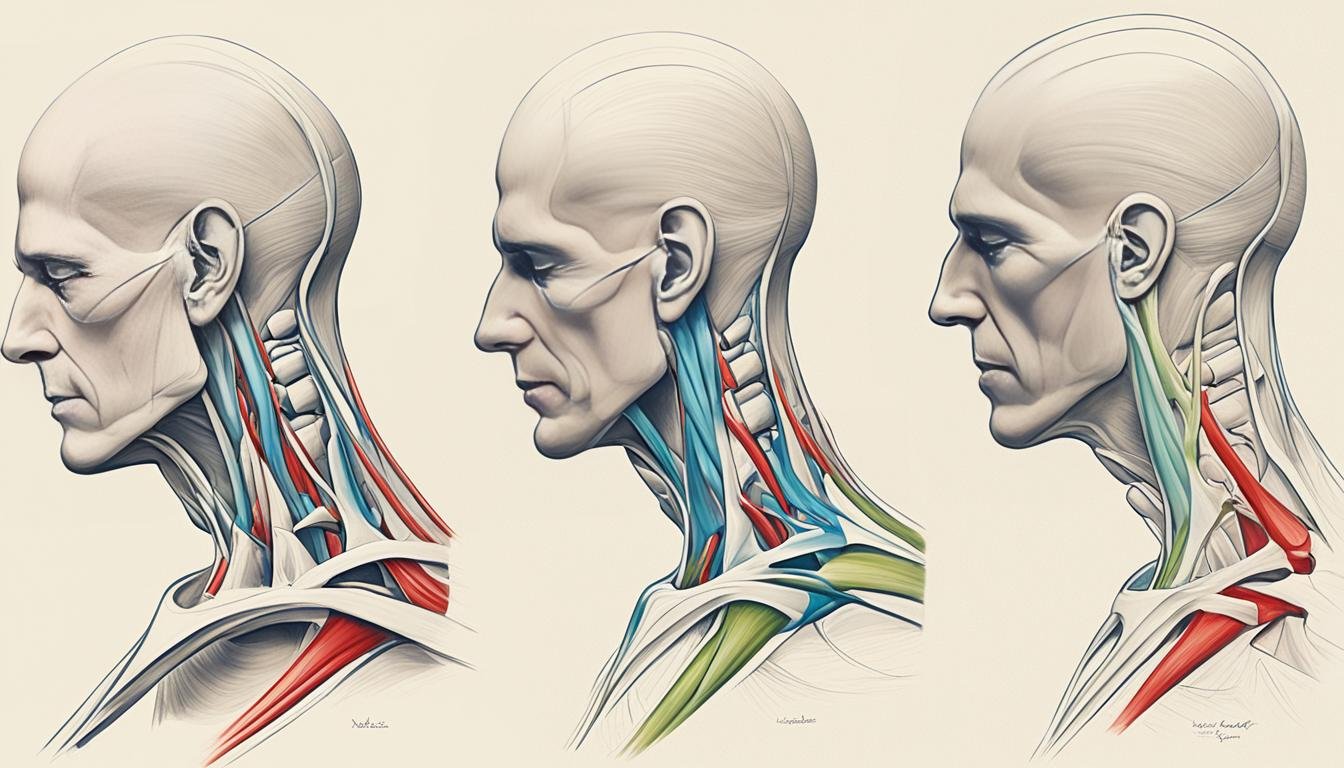Did you know that whiplash affects about 120,000 Americans each year? This common neck injury happens from rapid neck movements during a car or sports accident. Understanding causes, symptoms, and treatment is key for recovery. This includes getting help from firms like Super Attorneys Of Irvine.
Key Takeaways:
- Whiplash is a common neck injury caused by rapid back-and-forth movement of the neck, often seen in car accidents and sports accidents.
- Treatments for whiplash include immobilization, medications, cold and heat applications, exercise/physical therapy, TENS therapy, radiofrequency nerve ablation, and, in rare cases, spine surgery.
- Managing whiplash symptoms involves self-care measures such as wearing a cervical collar, gentle exercise, and neck muscle strengthening exercises after healing.
- Proper posture, safe driving habits, and maintaining overall health and fitness can help prevent muscle injuries and whiplash.
- If you have suffered a whiplash injury and require legal assistance, Super Attorneys Of Irvine can provide the necessary support and guidance for seeking compensation.
Whiplash Treatment Options
There are several ways to treat whiplash. These methods aim to lessen pain, heal the injury, and bring back normal neck function. Here are the main treatment strategies:
Immobilization
Early on, treating whiplash may include using a neck brace. This helps keep the neck still, protecting the spine. It lets the injury heal by not moving the hurt area.
Medications
Medicine can help with whiplash. It can ease pain, lessen swelling, relax muscles, and help with nerve pain. Doctors often prescribe pain relievers, anti-inflammatory drugs, and muscle relaxers.
Thermal Therapy
Cold and heat treatments can aid recovery from whiplash. Initially, cold packs reduce swelling. Later, heat therapy helps healing by improving blood flow.
Exercise and Physical Therapy
Physical therapy and exercises strengthen muscles and improve movement. A healthcare provider or therapist will show you exercises made for your situation.
Pain Management Techniques
Other ways to handle whiplash pain include TENS therapy and radiofrequency nerve ablation. TENS uses electrical currents to lessen pain. Radiofrequency nerve ablation targets nerves causing pain with heat.
Surgical Intervention
In extreme whiplash cases, spine surgery might be needed. It’s considered when other treatments don’t work. Surgery aims to fix the spine or ease nerve pressure.
Treatment for whiplash depends on the person. It’s important to talk to a doctor to get a plan that suits you.
| Treatment Options | Description |
|---|---|
| Immobilization | Wearing a cervical collar or brace to stabilize the neck and protect the spine and muscles from further damage. |
| Medications | Prescription of painkillers, anti-inflammatory drugs, muscle relaxants, and nerve blocks to manage pain, inflammation, spasms, and nerve-related issues. |
| Thermal Therapy | Use of cold packs to reduce initial swelling, followed by the application of heat to promote healing and improve blood circulation. |
| Exercise and Physical Therapy | Engaging in specific exercises and rehabilitation techniques to strengthen muscles, improve range of motion, and enhance functionality. |
| Pain Management Techniques | Utilization of TENS therapy and radiofrequency nerve ablation to relieve pain and target damaged nerves. |
| Surgical Intervention | Rarely required, spine surgery may be necessary in severe cases of whiplash when other treatments have failed. |
It’s crucial to get the right medical advice for whiplash treatment. Your specific situation needs a tailored plan. A healthcare professional can help choose the best treatments for your recovery.
Managing Whiplash Symptoms
After a whiplash injury, it’s key to manage symptoms and recover. Self-care and health provider tips can ease discomfort and help heal. Here are some ways to deal with whiplash:
1. Rest and Over-the-Counter Pain Medications
Enough rest is vital for minor whiplash recovery. Over-the-counter meds like ibuprofen or acetaminophen ease pain and lessen swelling. Always follow the dose guidance and check with a doctor if you’re on other meds or have health issues.
2. Cold and Heat Therapy
Using cold packs initially can reduce swelling and ease pain. Once swelling is down, heat therapy aids healing and relaxes muscles. Always protect your skin with a towel from direct hot or cold exposure to avoid damage.
3. Seeking Medical Attention
If pain lasts or you have nerve issues, see a doctor. Watch out for symptoms like fainting, dizziness, headaches, or difficulty with swallowing or speaking. These could mean a serious injury and need immediate medical care.
“If you experience moderate or persistent pain or notice signs of nerve-related problems, it’s important to seek medical attention.”
4. Cervical Collar and Gentle Exercise
A cervical collar might be suggested to support your neck. Be sure to use it as your healthcare provider advises. Later, gentle exercises can strengthen and flex neck muscles. Consult with a physical therapist to ensure safety in your exercises.>
5. Whiplash Recovery Timeline
The recovery time from whiplash varies by injury severity and health. Adhere to your healthcare provider’s recovery plan. It may involve slowly increasing physical activities and setting progress goals. Recovery is unique to each individual, so patience and listening to your body are important.
6. Muscle Injury Prevention Strategies
To prevent muscle injuries like whiplash, follow these key strategies:
- Maintain proper posture in daily activities, like sitting and lifting
- Drive safely, keep distance, and adjust the headrest properly
- Always buckle up in vehicles
- Regularly strengthen neck muscles for better stability and strength
By using these strategies daily, you can lessen the chance of muscle injuries, including whiplash.

| Whiplash Symptom | Expected Recovery Time |
|---|---|
| Mild neck pain and stiffness | A few days to a few weeks |
| Moderate to severe neck pain | A few weeks to a few months |
| Nerve-related symptoms (tingling, numbness) | Several weeks to several months |
| Severe injury requiring surgery | Longer recovery time, typically several months |
Recovery times vary by individual. Following doctor’s advice, self-care, and staying healthy speeds up whiplash recovery.
Neck Sprains and Strains
Neck sprains and strains often happen due to sudden movements. These can twist the neck in ways it shouldn’t, like in car crashes, sports, or falls. This can lead to pain, headaches, and even trouble moving your arms.
It’s key to get checked by a doctor if you hurt your neck. This is true even if you feel fine at first. A doctor can find out what’s wrong and suggest how to get better.
To treat a neck sprain or strain, various methods can help ease pain and heal. You might need to wear a soft neck collar or take medicine for pain and muscle spasms. Ice, heat, massage, and ultrasound therapy are also useful.
Healing takes time, and severe cases might need longer to recover. Listen to your doctor about when to start moving again. This helps make sure you heal well and safely.

Neck Sprains and Strains Treatment Options
There are many ways to treat neck sprains and strains. These can help you feel better, heal properly, and get back to daily life. Treatments include:
- Wearing a soft collar for support and immobilization of the neck
- Using over-the-counter pain relievers to manage discomfort
- Taking prescribed muscle relaxants to alleviate muscle spasms
- Applying ice and heat therapy to reduce inflammation and promote healing
- Incorporating massage therapy to relieve tension and improve circulation
- Utilizing ultrasound therapy to enhance tissue healing and reduce pain
A good treatment plan helps with pain relief and speeds up the healing of neck sprains and strains.
Whiplash: Causes, Symptoms, and Risk Factors
Whiplash is a neck injury from sudden back-and-forth motion, often in rear-end car crashes. It can also come from sports accidents, physical abuse, or falls.
The signs of whiplash include:
- Neck pain and stiffness
- Headaches
- Limited movement
- Shoulder and upper back pain
- Arm numbness
- Tiredness
- Dizziness
- Other symptoms like blurred vision, ringing ears, sleep issues, and mood swings
After an accident or injury, it’s vital to get checked by a doctor. This is to avoid worse harm. Risk factors for whiplash are rear-end car accidents, physical abuse, and contact sports.
Many recover from whiplash in weeks with the right care. Yet, some may have lasting pain and problems. Super Attorneys Of Irvine can help get compensation for such injuries.
Conclusion
Whiplash is a common issue that causes a lot of pain and discomfort in the neck. There are many treatments available, like wearing a neck brace, taking medicine, applying cold and heat, exercising, and going to physical therapy. For severe or lasting pain, and any nerve issues, it’s vital to get medical help.
To manage whiplash symptoms, take care of yourself and listen to your healthcare provider’s advice. Keeping a good posture, driving safely, using seat belts, and staying fit can prevent muscle injuries and whiplash. By being proactive, you can lessen the chance of suffering from this painful condition.
If a whiplash injury has occurred and you need legal help, Super Attorneys Of Irvine are ready to assist. They specialize in personal injury cases and can guide you in seeking fair compensation. You don’t have to go through it alone; reach out to Super Attorneys Of Irvine for support.

